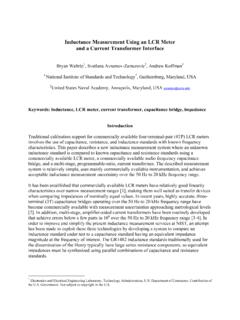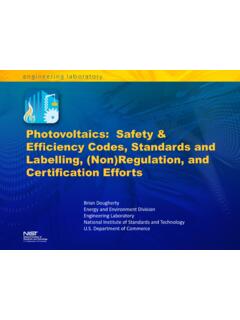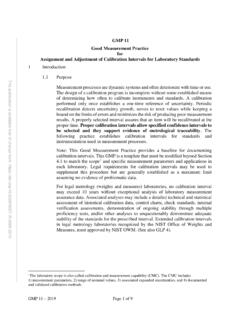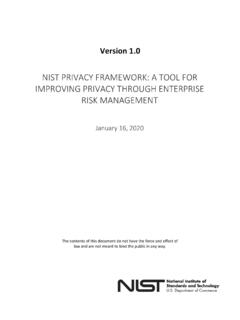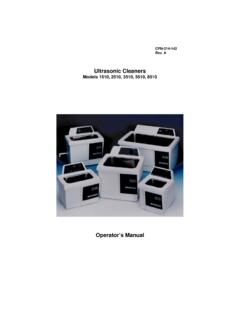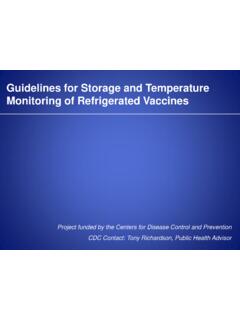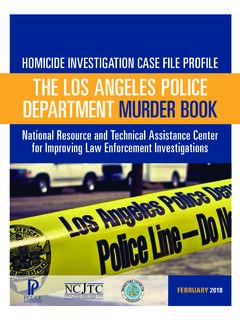Transcription of The Biological Evidence Preservation Handbook: Best ...
1 NISTIR 7928 The Biological Evidence Preservation Handbook: Best Practices for Evidence Handlers Technical Working Group on Biological Evidence Preservation Susan Ballou Mark Stolorow Melissa Taylor Law Enforcement Standards Office Office of Special Programs Phylis S. Bamberger Task Force on Wrongful Convictions New York State Bar Association Larry Brown Los Gatos/Monte Sereno Police Department Rebecca Brown Innocence Project Yvette Burney Scientific Investigation Division Los angeles Police Department Dennis Davenport Commerce City Police Department Lindsay DePalma Shannan Williams Booz Allen Hamilton Cynthia Jones American University Ralph Keaton American Society of Crime Laboratory Directors/ Laboratory Accreditation Board William Kiley Joseph Latta International Association for Property and Evidence Margaret Kline Biomolecular Measurement Division Material Measurements Laboratory Karen Lanning Evidence Control Unit Federal Bureau of Investigation Gerry LaPorte Office of Investigative and
2 Forensic Sciences National Institute of Justice Linda E. Ledray Sexual Assault Nurse Examiners/ Sexual Assault Response Team Randy Nagy LGC Forensics Brian E. Ostrom Portland Metro Forensic Laboratory Oregon State Police Lisa Schwind Office of the Public Defender State of Delaware Stephanie Stoiloff Forensic Services Bureau Miami-Dade Police Department April 2013 Department of Commerce Rebecca Blank, Acting Secretary National Institute of Standards and Technology Patrick D. Gallagher, Under Secretary of Commerce for Standards and Technology and Director Technical Working Group on Biological Evidence Preservation ii ii CONTENTS iiv I. Retaining Biological Evidence .. 1 II. Biological Evidence Safety and Handling .. 6 III.
3 Packaging and Storing Biological Evidence .. 9 IV. Tracking Biological Evidence Chain of Custody .. 25 V. Biological Evidence Disposition .. 37 Summary of Recommendations .. 43 Appendix A: Evidence Tracking and Management Systems: Functions, Capabilities, and Reports to be Considered when Acquiring a New System .. 46 Appendix B: List of Evidence Retention Laws .. 51 Appendix C: Sample Chain-of-Custody Report .. 55 Glossary .. 57 Works Cited .. 61 THE Biological Evidence Preservation HANDBOOK iii iii FIGURES Figure I-1: Collection of Evidence from large/bulky items. Figure II-1: Biohazard label. Figure III-1: Metal lockers used for Evidence drying. Figure III-2: Fiberglass shower enclosure. Figure III-3: Room designated for drying Evidence .
4 Figure III-4: Commercial drying unit. Figure III-5: Evidence stored in bags. Figure III-6: Evidence stored in envelopes. Figure III-7: Evidence syringe tube. Figure III-8: Storage for tubes or vials. Figure III-9: Sexual assault kits stored in boxes. Figure III-10: Sexual assault kits stored in envelopes. Figure III-11: Commercially manufactured Evidence lockers. Figure III-12: Repurposed lockers. Figure III-13: Evidence cages for large items. Figure III-14: Modified residential refrigerator. Figure III-15: Under-the-counter refrigerator. Figure III-16: Commercial Evidence refrigerator. Figure III-17: Commercial refrigeration units. Figure III-18: Labeled residential refrigerator/freezer. Figure III-19: Commercial walk-in refrigeration unit.
5 Figure III-20: Sample property/ Evidence room layout. Figure V-1: Example of a final disposition review request form. Figure V-2: Summary of process steps involved in Biological Evidence disposition. Figure V-3: Biohazard disposal bag. TABLES Table I-1: Examples of Sources of Biological Evidence Table I-2: Summary of Biological Evidence Retention Guidelines for Crime Categories Table III-1: Short-Term Storage Conditions Matrix Table III-2: Long-Term Storage Conditions Matrix Table IV-1: Notification Schedule for Pursuing Overdue Evidence Table V-1: Recommendations for Property Manual Standard Operating Procedures Technical Working Group on Biological Evidence Preservation iv iv INTRODUCTION Across the nation, headlines tell the story of Evidence that has been mishandled, misplaced, lost, or destroyed.
6 Often the blame for these mishaps is directed toward property and Evidence custodians housed in law enforcement agencies nationwide. Many law enforcement agencies do not properly address, recognize, or support the efforts of their property rooms. Although these agencies bear ultimate responsibility for maintaining the integrity of the Evidence , the real problem lies with a systemic failure to properly account for Evidence from collection through final disposition. This failure reduces the public s confidence in the criminal justice system to produce just results in criminal and civil proceedings. Biological Evidence refers to samples of Biological material such as hair, tissue, bones, teeth, blood, semen, or other bodily fluids or to Evidence items containing Biological material (DNA Initiative 2012).
7 This Biological Evidence , which may or may not have been previously analyzed at a forensic laboratory, should be retained in an appropriate storage facility until needed for court or for forensic testing. Such Evidence is frequently essential in linking someone to or excluding someone from crime scene Evidence . The criminal justice system depends on presenting Evidence to judges and jurors to help them reach a conclusion about the guilt or innocence of the defendant. All criminal justice stakeholders, including law enforcement officers, lawyers, forensic analysts, and fact finders, should be certain that the Biological Evidence they are considering has been properly preserved, processed, stored, and tracked to avoid contamination, premature destruction, or degradation.
8 In addition, individuals who come into contact with Biological Evidence , such as Evidence custodians, need to be confident that it has been packaged and labeled in a way that will allow them to efficiently locate relevant Evidence for a case. To establish this confidence, all handlers of Biological Evidence should follow well-defined procedures for its optimal Preservation . The Biological Evidence Preservation Handbook offers guidance for individuals involved in the collection, examination, tracking, packaging, storing, and disposition of Biological Evidence . This may include crime scene technicians, law enforcement officers, healthcare professionals, forensic scientists, forensic laboratory managers, Evidence supervisors, property managers, storage facility personnel , lawyers, testifying experts, court staff members, and anyone else who may come in contact with Biological Evidence .
9 While many of the recommendations relate to the physical storage, Preservation , and tracking of Evidence at the storage facility, this handbook also covers the transfer of the material between the storage facility and other locations and discusses how the Evidence should be handled at these other locations. This report is divided into five main sections that detail issues and make recommendations related to Biological Evidence storage, tracking, Preservation , and disposition. A glossary, which provides standard definitions of the technical terms used in this report, follows these sections. RETAINING Biological Evidence While most states have established their own statutes and/or policies for Biological Evidence retention, some have not.
10 It is imperative that high-level guidance be given to Biological Evidence handlers regarding the circumstances under which Evidence must be kept. This section defines recommended best practices for retaining Biological Evidence , including the length of time such Evidence should be kept. It also provides guidance on identifying what Biological Evidence should be retained. Biological Evidence HAZARDS AND HANDLING Contact with bodily fluids can spread disease such as those caused by bloodborne pathogens, and individuals handling Biological Evidence should treat it as hazardous to ensure safety. This section offers recommendations on various aspects of Biological Evidence handling, including the use of personal THE Biological Evidence Preservation HANDBOOK v v protective equipment (PPE), Federal standards, the management of spills or accidents, and Biological waste disposal.
